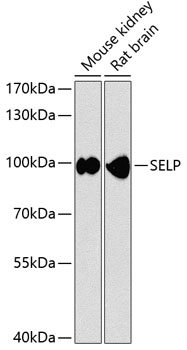Anti-SELP Antibody (CAB12512)
- SKU:
- CAB12512
- Product type:
- Antibody
- Reactivity:
- Mouse
- Rat
- Host Species:
- Rabbit
- Isotype:
- IgG
- Antibody Type:
- Polyclonal Antibody
- Research Area:
- Cell Biology
Description
| Antibody Name: | Anti-SELP Antibody |
| Antibody SKU: | CAB12512 |
| Antibody Size: | 20uL, 50uL, 100uL |
| Application: | WB |
| Reactivity: | Mouse, Rat |
| Host Species: | Rabbit |
| Immunogen: | Recombinant fusion protein containing a sequence corresponding to amino acids 220-319 of human SELP (NP_002996.2). |
| Application: | WB |
| Recommended Dilution: | WB 1:500 - 1:2000 |
| Reactivity: | Mouse, Rat |
| Positive Samples: | Mouse kidney, Rat brain |
| Immunogen: | Recombinant fusion protein containing a sequence corresponding to amino acids 220-319 of human SELP (NP_002996.2). |
| Purification Method: | Affinity purification |
| Storage Buffer: | Store at -20°C. Avoid freeze / thaw cycles. Buffer: PBS with 0.02% sodium azide, 50% glycerol, pH7.3. |
| Isotype: | IgG |
| Sequence: | FSFN SQCS FHCT DGYQ VNGP SKLE CLAS GIWT NKPP QCLA AQCP PLKI PERG NMTC LHSA KAFQ HQSS CSFS CEEG FALV GPEV VQCT ASGV WTAP APVC |
| Gene ID: | 6403 |
| Uniprot: | P16109 |
| Cellular Location: | Membrane, Single-pass type I membrane protein |
| Calculated MW: | 90kDa |
| Observed MW: | 100kDa |
| Synonyms: | SELP, CD62, CD62P, GMP140, GRMP, LECAM3, PADGEM, PSEL |
| Background: | This gene encodes a 140 kDa protein that is stored in the alpha-granules of platelets and Weibel-Palade bodies of endothelial cells. This protein redistributes to the plasma membrane during platelet activation and degranulation and mediates the interaction of activated endothelial cells or platelets with leukocytes. The membrane protein is a calcium-dependent receptor that binds to sialylated forms of Lewis blood group carbohydrate antigens on neutrophils and monocytes. Alternative splice variants may occur but are not well documented. |
| UniProt Protein Function: | SELP: Ca(2+)-dependent receptor for myeloid cells that binds to carbohydrates on neutrophils and monocytes. Mediates the interaction of activated endothelial cells or platelets with leukocytes. The ligand recognized is sialyl-Lewis X. Mediates rapid rolling of leukocyte rolling over vascular surfaces during the initial steps in inflammation through interaction with PSGL1. Defects in SELP may be a cause of susceptibility to ischemic stroke (ISCHSTR); also known as cerebrovascular accident or cerebral infarction. A stroke is an acute neurologic event leading to death of neural tissue of the brain and resulting in loss of motor, sensory and/or cognitive function. Ischemic strokes, resulting from vascular occlusion, is considered to be a highly complex disease consisting of a group of heterogeneous disorders with multiple genetic and environmental risk factors. Belongs to the selectin/LECAM family. |
| UniProt Protein Details: | Protein type:Membrane protein, integral; Cell adhesion Chromosomal Location of Human Ortholog: 1q22-q25 Cellular Component: nucleoplasm; extracellular space; platelet alpha granule membrane; integral to plasma membrane; cytoplasm; plasma membrane; platelet dense granule membrane; external side of plasma membrane Molecular Function:heparin binding; protein binding; lipopolysaccharide binding; glycosphingolipid binding; glycoprotein binding; calcium-dependent protein binding; sialic acid binding; fucose binding Biological Process: platelet activation; positive regulation of leukocyte migration; response to lipopolysaccharide; defense response to Gram-negative bacterium; heterophilic cell adhesion; positive regulation of phosphoinositide 3-kinase cascade; leukocyte adhesion; platelet degranulation; regulation of integrin activation; leukocyte tethering or rolling; blood coagulation; cell adhesion; inflammatory response; leukocyte migration Disease: Ige Responsiveness, Atopic |
| NCBI Summary: | This gene encodes a 140 kDa protein that is stored in the alpha-granules of platelets and Weibel-Palade bodies of endothelial cells. This protein redistributes to the plasma membrane during platelet activation and degranulation and mediates the interaction of activated endothelial cells or platelets with leukocytes. The membrane protein is a calcium-dependent receptor that binds to sialylated forms of Lewis blood group carbohydrate antigens on neutrophils and monocytes. Alternative splice variants may occur but are not well documented. [provided by RefSeq, Jul 2008] |
| UniProt Code: | P16109 |
| NCBI GenInfo Identifier: | 215274139 |
| NCBI Gene ID: | 6403 |
| NCBI Accession: | P16109.3 |
| UniProt Secondary Accession: | P16109,Q5R344, Q8IVD1, |
| UniProt Related Accession: | P16109 |
| Molecular Weight: | 90,834 Da |
| NCBI Full Name: | P-selectin |
| NCBI Synonym Full Names: | selectin P (granule membrane protein 140kDa, antigen CD62) |
| NCBI Official Symbol: | SELP |
| NCBI Official Synonym Symbols: | CD62; GRMP; PSEL; CD62P; GMP140; LECAM3; PADGEM |
| NCBI Protein Information: | P-selectin; GMP-140; granule membrane protein 140; granulocyte membrane protein; CD62 antigen-like family member P; platelet alpha-granule membrane protein; leukocyte-endothelial cell adhesion molecule 3; platelet activation dependent granule-external membrane protein |
| UniProt Protein Name: | P-selectin |
| UniProt Synonym Protein Names: | CD62 antigen-like family member P; Granule membrane protein 140; GMP-140; Leukocyte-endothelial cell adhesion molecule 3; LECAM3; Platelet activation dependent granule-external membrane protein; PADGEM; CD_antigen: CD62P |
| Protein Family: | P-selectin |
| UniProt Gene Name: | SELP |
| UniProt Entry Name: | LYAM3_HUMAN |





